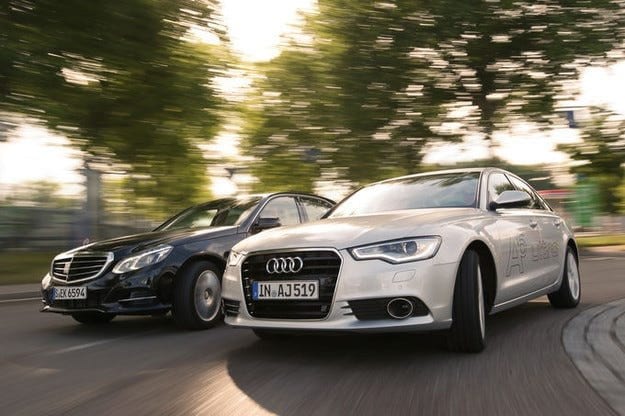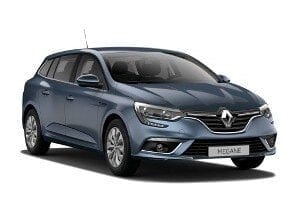
Test drive Audi A6 2.0 TDI Ultra vs Mercedes E 220 Bluetec: Cost? Superbly low!

Ten years ago, when it came to five-liter Audi and Mercedes sedans from the top class, we had in mind the super-powerful versions of the S6 and E 500. Today we call the 5-liter-per-100 km consuming A6 2.0 TDI Ultra and E 220 Bluetec, which can be efficient without depriving us of anything.
It is the deep conviction of all theorists who believe in a world conspiracy that there is nothing accidental about the simultaneous emergence of two economic models. It's just that the developers of Audi and Mercedes have delved deeper into the drawers of their desks. Immediately under the recipe for a low-calorie pizza, instructions for creating an electric car with an autonomous mileage of 700 km and a price of 15 euros and a plan to prevent global climate change, they found and brought out yellowed technical documentation for luxury limousines with a five-liter consumption. It has existed since the mid-000s, but secret agreements with the oil industry have hampered its implementation for decades.
Everyone else who does not believe in such conspiracies can easily admire us. Right now, the Audi A6 Ultra and Mercedes E 220 Bluetec are returning from the road and sports route to determine the lowest possible cost. Two large sedans with luxurious furnishings, 190 and 170 hp. and curb weight of more than 1,7 tons. Both covered 412 kilometers with careful and economical driving. At Audi, the fuel pump spray gun clicks after a little more than half an hour. Then it will take a little patience and skill to fill the tank to the brim, as in the beginning. However, even then it does not gain more than 20,19 liters, which is 4,9 l / 100 km. In Mercedes, we manage to fill up 23,01 liters, and the calculation shows a consumption of 5,6 liters / 100 km. Indeed, both models exceed the advertised 4,4L/100km limit, but dear friends and conspiracy theorists, this is a great achievement for two top class cars!
Even the average consumption in the entire test, which is 6 for the A6,8 and 220 l / 7,5 km for the E 100 Bluetec, is on par with small cars such as the Ford Ecosport 1.5 TDCi (6,8 l / 100 km) or the Peugeot Partner Tepee HDi 115 (7,5 l / 100 km). Even compared to the previous versions of the A6 2.0 TDI and E 220 Diesel, there is progress, although less. Thus, the Audi Ultra package has a 0,5 l/100 km advantage over the previous 2.0 TDI with manual transmission, and the E 220 Bluetec is 0,3 l/100 km more economical than the conventional 220 CDI with seven-speed automatic transmission. And this is without the client being deprived of absolutely nothing.
Against the backdrop of these achievements, austerity measures seem almost insignificant. For Audi, the most important thing is that the model received a newly developed seven-speed dual-clutch gearbox. It increases drive efficiency with less friction and two separate oil circuits - one for the two clutches, mechatronic module and oil pump, and the other for the gear sets and differential. In Efficient mode, the S-tronic transmission shifts to idle when the throttle is released (as if the car were sailing using maximum inertia). There is also a centrifugal pendulum known from the Efficient Dynamics Edition variants. bmw. And in the S-tronic A6, it counteracts vibrations that occur at low speeds and thus allows driving at particularly low speeds. The A6 handles this very well - just above idle, the car starts to pull smoothly. But not too violent, because it holds back the "long" transmission ratio and engine performance. Only at 1750 rpm does the smooth two-liter unit reach its maximum torque of 400 Nm.
Mercedes and the power of calm
With the slightly louder E 220 Bluetec, the plateau of 400 Nm has already risen to 1400 and lasts up to 2800 rpm. Even before there was a turbocharger, it was completely erased by a seven-speed automatic with a torque converter. With it, the Mercedes model accelerates more aggressively. There are also fuel-saving details here: for example, the automatic transmission shifts gears according to a particularly efficient shift strategy, which is mainly aimed at not requiring high engine revs. When it collides with the switch plates, the automaton reacts with, shall we say, suppressed euphoria. Even so, there is no point in high revs because 170 horsepower is available at 3000 rpm. Like the Audi A6 Ultra, the gear ratios on the E 220 Bluetec are so long that at 200 km / h on the motorway, the engine spins at just 2500 rpm.
Other economy tricks in the E-Class are modestly limited to low-resistance tires and front-radiator shutters that close when no airflow is needed for cooling, thereby reducing air resistance. This is the purpose of the standard sports suspension, with which Bluetec cuts the oncoming airflow 15mm lower. However, the test car is equipped with air suspension - for an additional fee (4084 leva), but with excellent performance. Only with transverse joints reacts a little sharply, but this is a feature of the system. Unlike the tighter Audi, the Mercedes model, with its velvety softness and no wobble, neutralizes both short and long waves on the pavement - both fully and fully loaded.
The load in question in the test machine is limited to a paltry 396 kilograms. In addition, the volume of the trunk is less here and is 490 liters. This is because in the Bluetec Euro 6 versions the Adblue tank is located under the floor of the luggage compartment, so there are no 50 liters of "cellar" that Mercedes classifies as a luggage compartment.
Ultra is the new name for normality
A6 complies with Euro 6 requirements without affecting the offered space in any way. In general, the only difficulty in communicating with the test machine is quite aesthetic - these are huge "Ultra" inscriptions on both sides of the case. In them, Audi publicly declares the important and independent role of the model – while Mercedes offers both the E 220 CDI and the E 220 Bluetec, the A6 2.0 TDI will only be produced in an economical version.
In it, the model costs about 2000 leva more, it is more powerful by 13 hp. and retains its known strengths. The advantage of 131 horsepower and 651 kilograms less than the E-Class finds expression in faster acceleration. Unlike the OM 6 in the Mercedes, Audi's XNUMX-liter engine revs more easily and the S-tronic transmission responds spontaneously to switch commands. This dynamic character is also combined with more agile handling, with which AXNUMX travels unobtrusively quickly and extremely safely on the road. There is no steering feedback yet.
The E-Class takes corners more calmly, but with a more authentic feel. The car handles fast corners professionally, not enthusiastically - with little understeer, uncompromising safety and under the competent control of the ESP system. Both models offer a rich arsenal of support systems that leave little chance for the driver to get into an accident. It is all the more strange that in the 100 km / h test and hot brakes, the E-Class admitted a slight weakness of the 1,9-meter increase in braking distance.
We add that both cars offer the same spaciousness in the cabin, excellent workmanship, good ergonomics (with the exception of details such as the MMI menu in the A6 and the on-board computer in the E-Class) and are about equally expensive.
In the end, the Ultra wins by showing how economical the top class can be if the buyer doesn't forgo something substantial. If you don't believe me, see for yourself by checking the steering wheel behind the wheel. You can't help but feel it - even if you think it's all part of a conspiracy.
CONCLUSION
1 AUDI
530 points
The huge money and effort that Audi invests in engine development pays off well. Extremely economical yet temperamental and fluid, the A6 Ultra is crowned with victory. Small deficiencies in suspension comfort are offset by significantly lower costs.
2 Mercedes
516 points
When your opponent is A6, you have no right to show weakness. The 220 Bluetec, however, can afford them - smaller payload, higher cost and higher price (in Germany). In terms of comfort, the model remains the benchmark, while the powerful and quiet drive convinces.
Text: Sebastian Renz
Photo: Hans-Dieter Zeifert
Home " Articles " Blanks » Audi A6 2.0 TDI Ultra vs Mercedes E 220 Bluetec: Cost? Superbly low!
